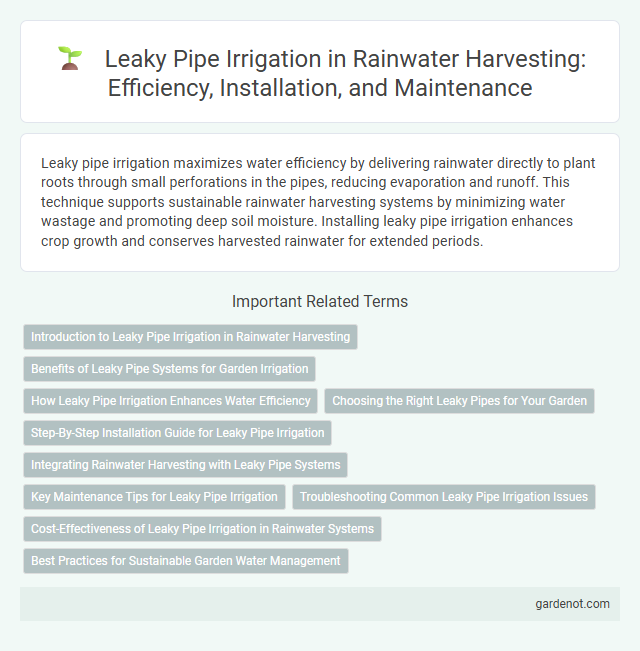Leaky pipe irrigation maximizes water efficiency by delivering rainwater directly to plant roots through small perforations in the pipes, reducing evaporation and runoff. This technique supports sustainable rainwater harvesting systems by minimizing water wastage and promoting deep soil moisture. Installing leaky pipe irrigation enhances crop growth and conserves harvested rainwater for extended periods.
Introduction to Leaky Pipe Irrigation in Rainwater Harvesting
Leaky pipe irrigation is an efficient method for distributing harvested rainwater directly to plant roots, minimizing water loss through evaporation or runoff. This system utilizes perforated pipes buried underground, allowing slow, consistent water release that enhances soil moisture retention. Integrating leaky pipe irrigation within rainwater harvesting maximizes resource use and promotes sustainable agriculture.
Benefits of Leaky Pipe Systems for Garden Irrigation
Leaky pipe irrigation systems enhance water efficiency by delivering moisture directly to plant roots, minimizing evaporation and runoff. These systems reduce water consumption by up to 50% compared to traditional sprinkler methods, promoting sustainable garden irrigation practices. Consistent soil moisture from leaky pipes improves plant health and growth, supporting vibrant, resilient garden ecosystems.
How Leaky Pipe Irrigation Enhances Water Efficiency
Leaky pipe irrigation enhances water efficiency by delivering a slow, steady supply of water directly to plant roots, minimizing evaporation and runoff. The controlled leakage through perforations ensures uniform soil moisture, promoting healthier plant growth and reducing water waste. This system integrates effectively with rainwater harvesting, optimizing harvested water use for sustainable irrigation.
Choosing the Right Leaky Pipes for Your Garden
Selecting the right leaky pipes for your garden involves considering pipe material, pore size, and length to ensure efficient water distribution and optimal soil moisture retention. PVC and polyethylene are popular materials due to their durability and resistance to clogging, while pore sizes should match your soil type to prevent waterlogging or insufficient irrigation. Properly sizing and spacing pipes according to garden layout maximizes rainwater harvesting benefits and supports sustainable plant growth.
Step-By-Step Installation Guide for Leaky Pipe Irrigation
Leaky pipe irrigation involves installing porous pipes that slowly release water directly to plant roots, enhancing water efficiency in rainwater harvesting systems. Begin by selecting durable, UV-resistant leaky pipes and measuring the garden layout to place them evenly along irrigation zones. Next, trench shallow grooves for the pipes, connect them to a rainwater storage tank via a pressure regulator, and cover the pipes with mulch to reduce evaporation and maximize moisture retention.
Integrating Rainwater Harvesting with Leaky Pipe Systems
Integrating rainwater harvesting with leaky pipe irrigation enhances water efficiency by channeling collected rainwater directly into subsurface irrigation lines, minimizing evaporation and runoff. This system supports sustainable agriculture by delivering precise moisture levels to plant roots, optimizing crop yield while conserving freshwater resources. Combining these technologies reduces dependence on groundwater and promotes eco-friendly irrigation practices.
Key Maintenance Tips for Leaky Pipe Irrigation
Regularly inspect leaky pipe irrigation systems for cracks and punctures to prevent water loss and ensure efficient water distribution. Clean filters and flush pipelines periodically to avoid clogging caused by sediment buildup, which can impair system performance. Monitor water pressure consistently to maintain optimal flow rates and prevent pipe damage from excessive pressure fluctuations.
Troubleshooting Common Leaky Pipe Irrigation Issues
Leaky pipe irrigation systems often face common issues such as pressure drops, uneven water distribution, and clogged emitters. Regular inspection for cracks, joint leaks, and proper sealing with high-quality fittings can prevent water wastage and maintain system efficiency. Ensuring correct pipe alignment and using pressure regulators helps optimize water flow and reduces maintenance costs.
Cost-Effectiveness of Leaky Pipe Irrigation in Rainwater Systems
Leaky pipe irrigation in rainwater harvesting systems significantly reduces water wastage and operational costs by minimizing evaporation and runoff. The simple design and low maintenance requirements contribute to its affordability compared to traditional irrigation methods. This efficient water delivery system enhances crop yield while optimizing resource use, making it a cost-effective solution for sustainable agriculture.
Best Practices for Sustainable Garden Water Management
Leaky pipe irrigation enhances rainwater harvesting by delivering slow, consistent moisture directly to plant roots, reducing water waste and soil erosion. Using durable, UV-resistant tubing and regularly checking for clogs or leaks ensures efficient water distribution in sustainable garden water management. Integrating rainwater storage tanks and automated drip systems maximizes conservation efforts while maintaining optimal soil hydration.
Leaky pipe irrigation Infographic

 gardenot.com
gardenot.com